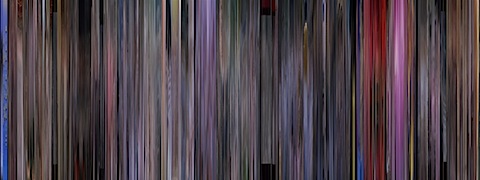Arcade Fire closed their Coachella set with the anthemic “Wake Up,” adding some crowd interaction with a couple hundred glow in the dark, multi-colored beach balls.
Category: Creativity
How things are created, mainly dealing with the process and means of creation
-
Fade
Fade is an addicting Flash game, where you guide a llama, hurdling over cliffs and shrubbery as it picks up speed to see the world in perfect color. See, the game starts in black and white, and as the llama picks up speed, somewhere around 35mph, the world begins to turn to color. You earn points for distance traveled to spend on skill power ups to go even farther. Also, there are achievements, if you need that sort of thing to validate your gaming experience.
-
Record player wedding invite
Graphic designer Kelli Anderson creates a wedding invitation for her friends Mike and Karen that forms a papercraft record player.
The resulting booklet is comprised of a cover, two inner pages, a letterpressed band (with instructions and a tear-off RSVP postcard), and a flexdisc on a screwpost. The recipient bends the second page of the booklet back to create a tented “arm.†With the needle placed, they then carefully spin the flexidisc at 45 RPM (ish) to hear the song.
-
Graph Racers
I guess I’m a little late to this, but Graph Racers is a pretty nifty concept. Take some graph paper, make a course, get at least 2 players, each with their own colored marker and have them race around the graph paper track.

-
How to steal like an artist
I nodded my head all the way through Austin Kleon’s “How to steal like an artist.”
Every new idea is just a mashup or a remix of previous ideas.
If there’s one takeaway for self-described non-creative people, it is that. Synthesize, combine, mash up what you already know, and then you’ll come away with something unique.
-
Framing pixels
A member of Chase Jarvis’ team writes up how they mounted iPads for an art installation:
The challenges: iPads are designed to be interactive, to move between apps. How do you keep people from messing with them, checking their email, pointing them at un-savory sites, or worse yet walking away with them entirely?
-
Designing a Photograph – Bill Smith

Designing a Photograph: Visual Techniques for Making Your Photographs Work by Bill Smith takes a designer’s view of to a photograph. Visually, what makes something interesting or engaging, and apply it to a photograph. Smith makes the argument of knowing how to pay attention to groups of visuals. These visuals include:
- Figure ground
- selective focus
- similar color
- closure
- continuation
- similar size and shape
- similar texture
- object proximity
The book includes exercises for the reader to perform (shoot in bursts, look at a subject a variety of different ways). Later in the book, Smith details when black and white works better or if color is optimal. Consider contrast and tones and how light affects both.
Images do have f stop and lens information for those curious of technical details.
Designing feels dated, even for 2001, retaining sample images taken with Kodachrome. Kodachrome is dead, and even in 2001 was gasping its final breaths. Ignoring that, applying a designer’s eye to photography can help tremendously with composition and achieving the desired impact.
-
100 days – a design challenge
Michael Bierut has challenged students at Yale to perform a “design operation” for 100 days.
The only restrictions on the operation you choose is that it must be repeated in some form every day, and that every iteration must be documented for eventual presentation. The medium is open, as is the final form of the presentation on the 100th day.
An additional challenge I see, beyond solving the design problem of the day is having the perseverance, especially through the traditional Hanukkah, Christmas, New Years’ holidays. Being creative and getting something done are two separate things. Doing both, together, for 100 days is a feat. And these exercises are more than a picture a day or a self portrait a day. They have purpose, utility or function.
-
The Tao of Photography –
Tao of Photography: Seeing Beyond Seeing by Philippe L. Gross, S.I. Shapiro applies Zen concepts to photography, interspersed with quotes and anecdotes from photographers that were well known for their visionary approach to what they took pictures of. Each section contains principles, applications of the principles and suggested assignments one can do to apply the principles.
The biggest takeaways from the book are the principles of Great Understanding and Little Understanding. The former refers to the unconscious and receptive nature of self. In photography this applies to composition and feeling of the subject. Little Understanding focuses on the small and immediate, this being tools and equipment available to a photographer. You need both in photography. Often, photographers focus solely on gear and techniques that they forget to seek out something larger in their work.
One way to seek something larger, to filter out unnecessary details, is to constantly discriminate to see the most basic, essential aspects of a photographic vision. Discriminating is not the same as being critical. You actively choose what is needed, not why it’s not needed.
I’d definitely recommend this book to understand a different creative approach. The quotes from famous photographers and personal stories are insightful.
